Do you listen to the chirping tunes of your budgie and wonder if those melodious notes are coming from a male or a female budgie?
Well, identifying the gender of these little feathered companions can be quite the puzzle, but not to worry.
This comprehensive guide is here to help!
Determining the gender of a budgie requires careful observation of various factors such as cere color, feather color, voice, body shape, and behavior.
Each of these can offer clues about your budgie’s sex.
It’s important to remember that these traits may vary based on the budgie’s age and genetic mutations.
Step By Step Budgie Gender Identification & Gender-Specific Differences
Differentiating between male and female budgies involves a close observation of physical traits and behavioral patterns.
Check the Cere Color
The color of the cere, the fleshy, bump-filled area above a budgie’s beak where the nostrils are located, is one of the most reliable indicators of a budgie’s sex.
In most cases, male budgies have a blue or purplish-blue cere, while females have a cere that is white, tan, beige, or brown, particularly when they are in the breeding season.
In younger budgies, both males and females can have a pink or purplish cere, which makes sexing difficult.
It’s also important to note that certain budgie mutations can cause variations in cere color, making gender identification more challenging.
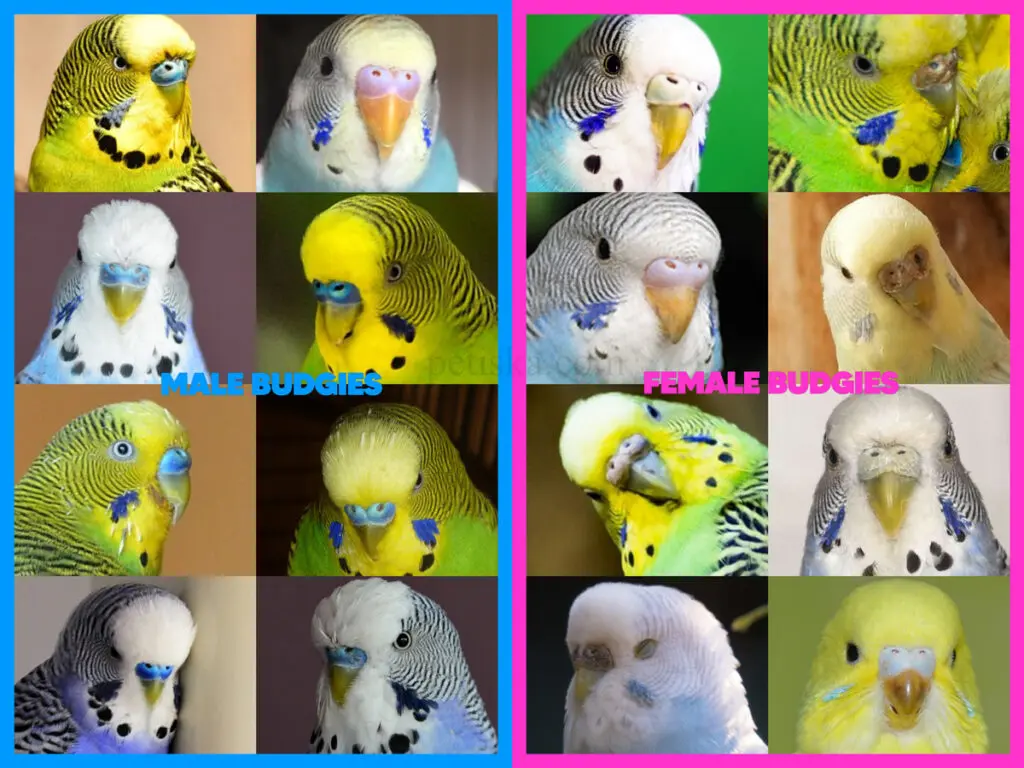
Check Feet and Legs
Examining a budgie’s feet and legs can offer subtle hints about its sex.
Males generally have smoother and shinier legs and feet, while females often have rougher and duller legs.
Sex hormones can also affect the color of budgies’ feet. The color change caused by the hormones in the color of the cere can also be seen in the color of the feet.
Also, females tend to have slightly thicker legs compared to males.
It’s important to understand, however, that this is not a definitive method for determining a budgie’s sex as there can be significant overlap and variation in leg and foot texture and thickness between individual budgies.
Therefore, it’s advisable to consider this trait in combination with other gender-specific characteristics such as cere color, feather coloration, and behavioral patterns.
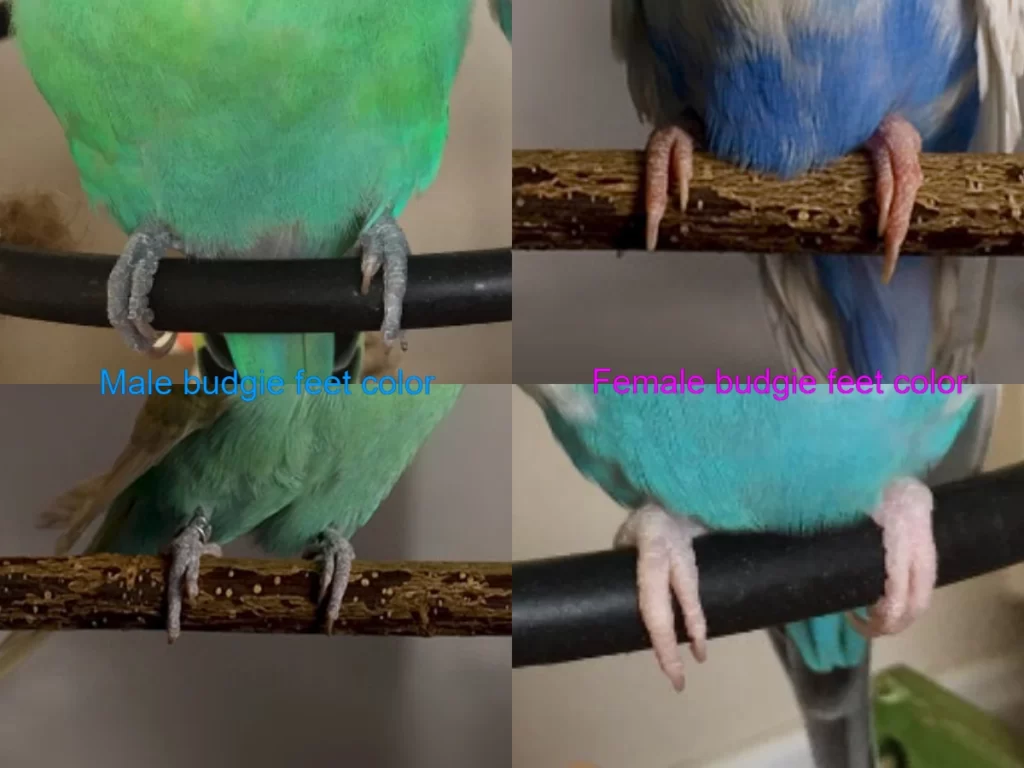
Check Feather Coloration
Feather coloration can serve as a helpful hint when determining a budgie’s sex.
Generally, males often exhibit brighter, more vibrant color patterns, especially around their faces.
On the other hand, females tend to have more muted and subdued hues.
However, the specific colors can vary greatly due to genetics and various budgie mutations, making this method less reliable on its own.
Furthermore, age can also influence a budgie’s coloration as younger budgies often don’t develop their full adult coloration until they’ve matured.
Therefore, feather coloration should ideally be considered alongside other traits such as cere color and behavioral patterns to accurately determine a budgie’s sex.
Consider Behavioral Differences, Socializing Behavior
Observing a budgie’s behavior can offer valuable insights into its sex.
In general, male and female budgies display different social behaviors which can serve as helpful indicators.
Male budgies are usually more social, playful, and outgoing than their female counterparts.
They often enjoy interacting with their human caretakers, toys, and other budgies.
You may observe them indulging in playful activities, such as singing, chirping, and mimicking sounds.
Males are known for their more melodious and complex vocalizations, often used to attract females.
Females, on the other hand, tend to be more independent and assertive.
While they also enjoy socializing, their interactions tend to be more straightforward, and they often show less interest in play compared to males.
Female budgies are also generally more dominant and may display territorial behaviors, especially during the breeding season.
It’s important to remember, though, that these behavioral characteristics can vary between individual budgies, and external factors such as environment, upbringing, and socialization can influence them.
Therefore, while behavioral patterns can serve as a useful guide, they should not be used as the sole determinant of a budgie’s sex.
Always consider these behaviors in conjunction with physical traits like cere color, feather coloration, and body shape for a more comprehensive and accurate sex determination.
Observe Courtship Behavior
Courtship behavior in budgies can provide clues to their sex.
Male budgies often exhibit more pronounced courtship behaviors, such as singing complex tunes, puffing up their feathers, bowing their heads, and bobbing their heads up and down to attract a mate.
They might also feed the females as part of their courtship ritual.
Females, on the other hand, are generally less demonstrative.
They might respond to males’ advances by preening or nibbling at them but usually do not initiate the courtship.
Check for Voice Differences, the Noise Levels and Talking Abilities
Voice differences, noise levels, and talking abilities can offer significant clues when determining the sex of a budgie.
Male budgies are often more vocal, engaging in extensive singing and chatter, which can be quite loud at times.
They have a broader range of sounds and are more likely to mimic human speech and noises.
On the contrary, females tend to be quieter, with their vocalizations typically consisting of shorter chirps, squawks, and basic chatters.
Check the Body Shape
The body shape can provide some clues to your budgie’s gender.
Males generally have a more streamlined body, while females can be a bit broader and stockier.
Check the Tail Feathers
The tail feathers of a budgie can also provide hints about its sex.
Male budgies generally have longer and more pointed tail feathers, contributing to their overall sleek and streamlined appearance.
On the other hand, females usually have shorter and rounder tail feathers, resulting in a more compact and robust look.
However, this feature can be influenced by age, genetics, and health status and should not be used as the only determinant for sexing your budgie.
It’s advisable to consider tail feather characteristics alongside other physical traits like cere color and body shape, as well as behavioral cues for a more reliable sex determination.
Check the Cheek (Throat) Spots
Cheek spots, also known as throat spots, are another characteristic to consider while determining a budgie’s sex.
Males often possess brighter and more vivid cheek spots, while females may exhibit somewhat duller spots.
However, this trait isn’t universally applicable, as the cheek spot’s color intensity can vary significantly among different budgie mutations.
Moreover, factors like age and overall health can influence the brightness of a budgie’s cheek spots.
Hence, while examining the cheek spots may provide additional clues about a budgie’s sex, it should be combined with other sexing methods like observing the cere color, considering behavioral patterns, and analyzing the physical features for a comprehensive assessment.
Check the Biting Tendency
Biting tendency can be another behavioral cue in determining a budgie’s sex.
Typically, female budgies tend to be a bit more aggressive and more likely to bite compared to males, especially during their breeding period.
Males, on the other hand, are generally less aggressive and less likely to bite.
However, it’s important to remember that this characteristic can be influenced by various factors, including the budgie’s individual personality, its level of trust with humans, and overall comfort in its environment.
Young, Baby Budgie Nostrils
In young budgies, determining sex can be more challenging as both sexes have similar ceres with pinkish or purplish coloration.
However, young female budgies might start showing white rings around their nostrils (the fleshy part of the cere) earlier than males, usually around 8-12 weeks.
This white ring becomes more pronounced as they mature and eventually turns crusty brown when they reach sexual maturity.
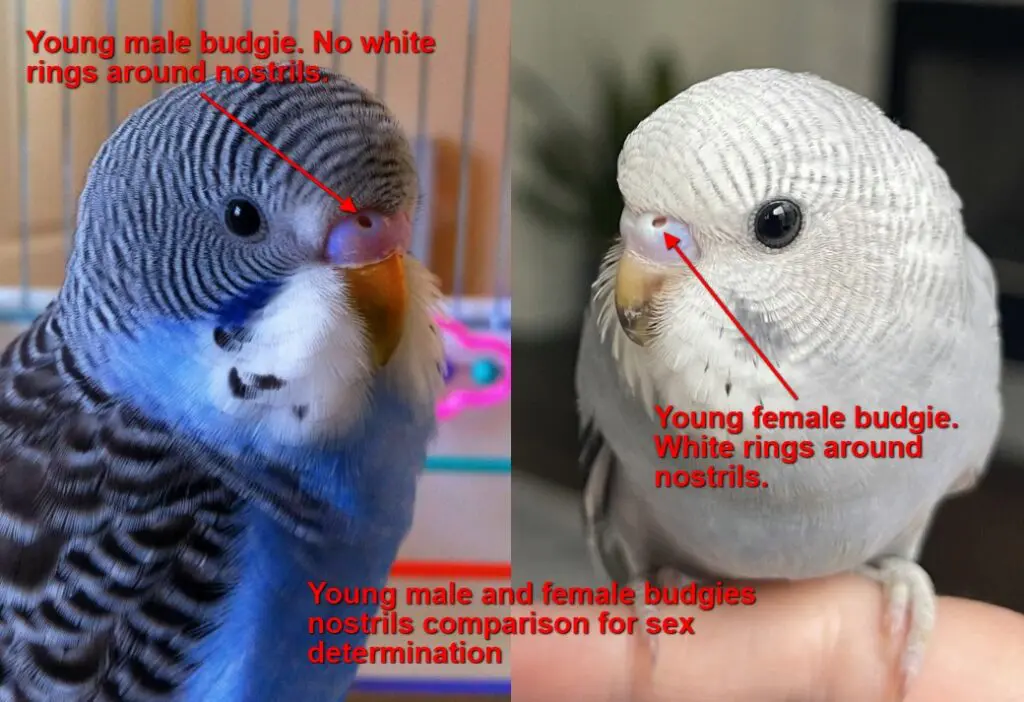
Females Lay Eggs (Obviously)
If your budgie lays eggs, then it’s definitely a female.
DNA (Genetic) Test
If physical and behavioral indicators don’t conclusively determine your budgie’s sex, a DNA (genetic) test can provide a definitive answer.
This method involves collecting a feather, blood, or eggshell sample and sending it to a lab for DNA analysis.
The test identifies the sex chromosomes in the DNA of your budgie – ZZ for males and ZW for females.
While the DNA test is the most accurate method for sexing a budgie, it is more costly and time-consuming than other methods.
It also requires professional assistance to collect the sample safely and correctly without causing harm or stress to the budgie.
Sex Determination by Cere Color
Each budgie is unique, and their cere colors may vary widely depending on their age, health, and mutation type.
However, the general guideline remains – males typically have blue ceres, while females usually have pink or brown ceres.
Young budgies of both sexes have pinkish or purplish ceres, making gender identification trickier in the first few months of their lives.
Male: Blue, Light Blue, Or Pale Blue To A Deeper (Dark) Blue
In most cases, male budgies display a blue, light blue, or even pale blue cere.
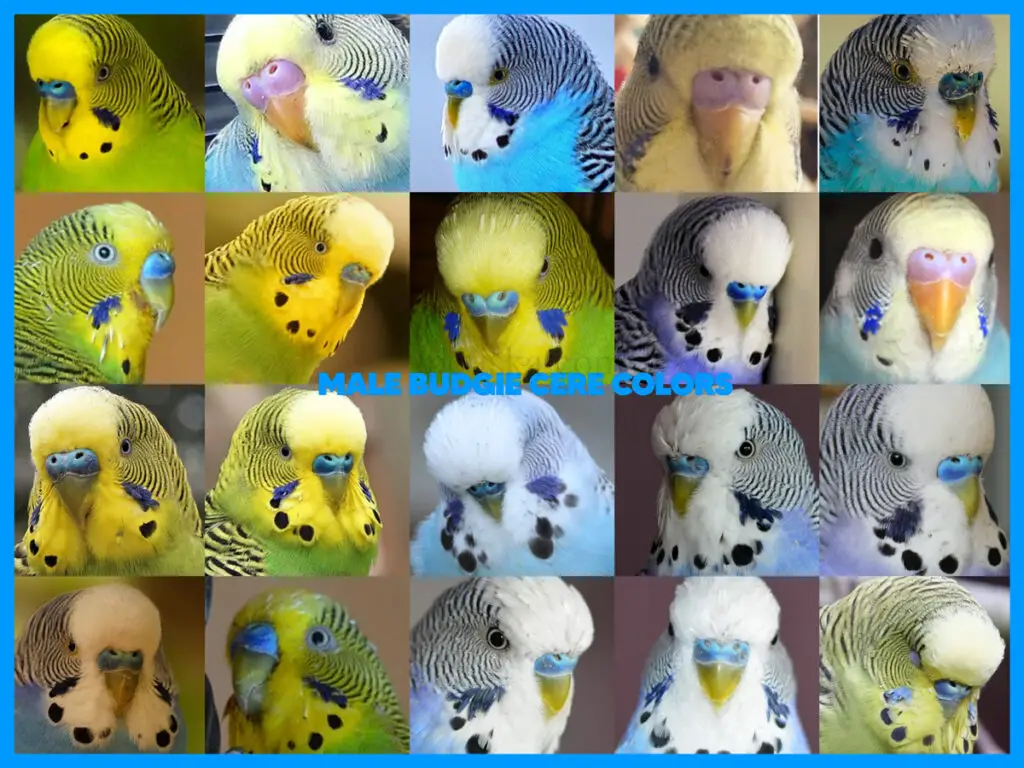
This coloration serves as a relatively reliable indicator of their sex.
The cere, a fleshy, raised area located at the top of the beak, houses the nostrils.
The hue of this area is often instrumental in budgie sex determination.
During the budgie’s maturity and breeding readiness, the blue color of the male cere often intensifies.
This deepening of color can be described as a shift from a pale or light blue to a more profound, dark blue.
This darker shade is usually more prominent around the nostril area.
It’s important to note, however, that the specific shade of blue can vary between individual budgies due to factors like genetics, diet, and overall health.
Certain budgie mutations may also influence cere color, causing it to display hues not typically associated with the standard male color spectrum.
Therefore, while the blue cere is a good initial indicator of a male budgie, it’s beneficial to consider other physical and behavioral characteristics to confirm the sex accurately.
Female: Pink, White, Tan, Brown And Beige Cere Color To Darker, Crusty Brown
Female budgies often have a pink, white, tan, or beige cere, which can help distinguish them from their male counterparts.
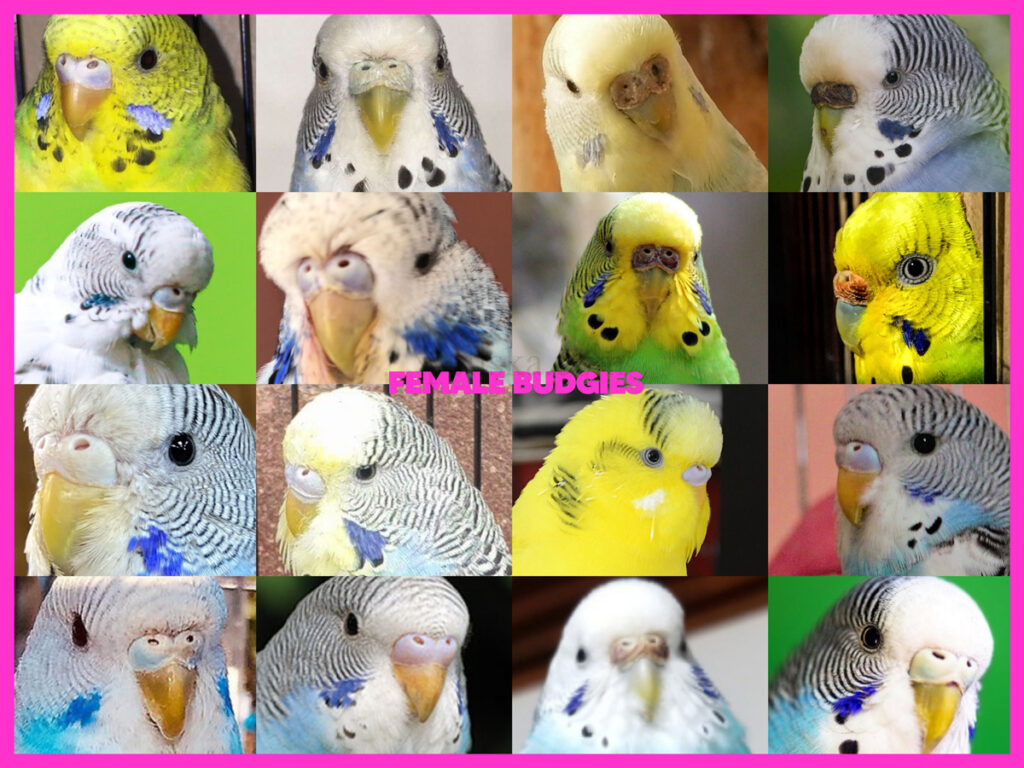
The cere, a fleshy area located above the beak containing the nostrils, often changes color as the budgie matures and enters different breeding cycles.
In the non-breeding season, a female budgie’s cere color can range from pink to white, tan or beige.
However, when she enters the breeding season and is ready to lay eggs, the cere can darken to a brown color.
At times, it can even develop a distinctive crusty texture.
This change is influenced by hormonal fluctuations associated with reproduction.
Similar to males, the cere color in females can also vary based on individual genetic factors and overall health.
Certain budgie mutations may cause the cere to display colors that deviate from the standard female spectrum.
Despite the cere color being a reliable gender identifier, it’s essential to consider other signs such as behavior, voice, and body shape for a comprehensive understanding of your budgie’s sex.
Young: Pinkish Or Purplish Cere Color
Young budgies, typically those under six months of age, often exhibit a pinkish or purplish cere color, regardless of their sex.
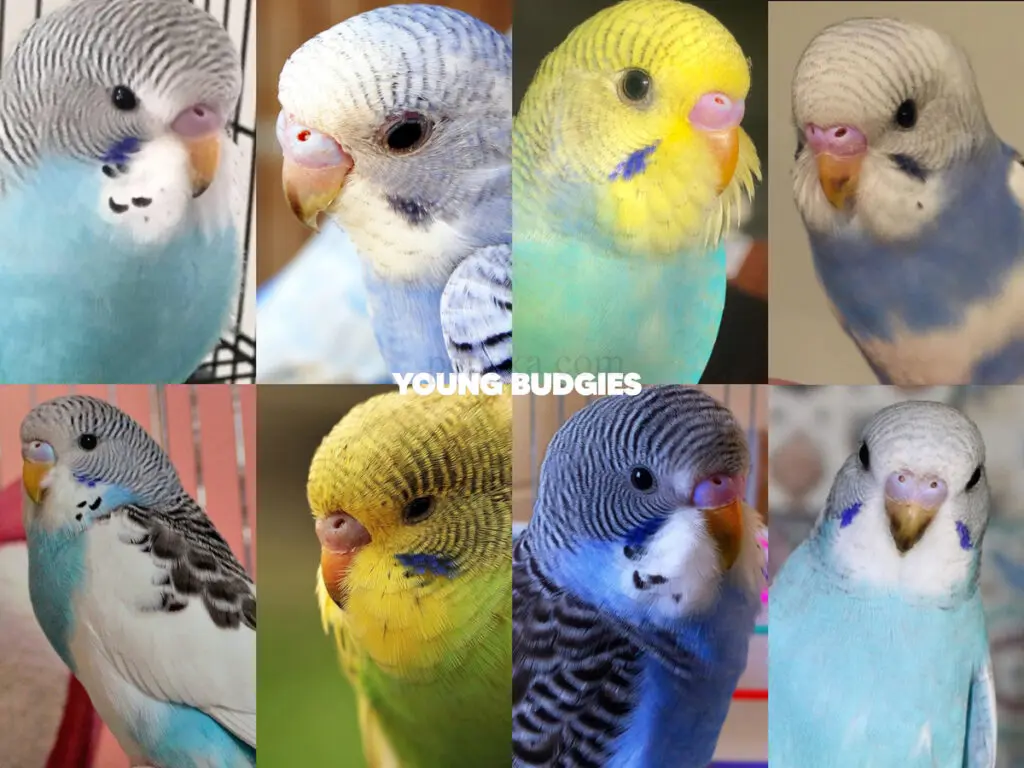
The cere, the fleshy area above the beak that contains the nostrils, is generally not a reliable indicator of a budgie’s sex during this stage of their life.
The similarity in cere color between young males and females can make it quite challenging to accurately determine their gender.
The cere’s pinkish or purplish hue in young budgies is part of their normal growth and development.
As these budgies mature and reach sexual maturity, which usually happens around six months of age, their cere color will start to change.
Males will develop a more blue-toned cere, while females typically exhibit a change towards whiteish, tan or beige, and eventually to a darker, crusty brown during breeding season.
However, it’s crucial to note that the timing of these changes can vary between individual budgies.
Some might show signs of their definitive cere color earlier, while others might take longer.
Moreover, certain genetic mutations can influence the color of the cere, leading to variations that might not align with the standard color spectrum.
Budgie Mutations Always Changes the Cere Color
The fascinating world of budgie mutations adds another layer of complexity to gender identification.
Certain budgie mutations can alter the cere color, making it nearly impossible to identify the sex based solely on this characteristic.
FAQs
Why Don’t We Look at the Reproductive Organs to Determine Sex in Budgies?
Unlike many animals, budgies, like other birds, have internal reproductive organs.
This makes it impossible to determine their sex by merely looking at them.
The only definitive way to determine a budgie’s sex through their reproductive organs would be through surgical sexing, which is both invasive and unnecessary, considering the alternative non-invasive methods available.
Is My Budgie with a Black Ceres Male or Female?
A budgie with a black cere can be a cause for concern rather than an indicator of its sex.
Both male and female budgies typically do not have black ceres.
If you notice a black cere on your budgie, it’s advised to consult a veterinarian as this could indicate a health issue.
Do Female Budgies Get Brown Ceres?
Yes, female budgies can indeed have brown ceres.
However, this usually occurs when they are in breeding condition.
Outside of the breeding season, a female budgie’s cere may revert back to a lighter color such as white, tan or beige.
Do Male Budgies Get Brown Ceres?
In normal circumstances, a male budgie should not have a brown cere.
If you observe a brown cere in a budgie that has previously displayed a blue cere, it could indicate a potential health issue such as a hormonal imbalance.
In such cases, it’s best to consult with a vet.
Are Male Budgies Bigger Than Females?
Generally, male and female budgies are similar in size.
However, some individual differences may occur.
The overall size of a budgie can be influenced by factors such as its diet, overall health, and genetics, rather than its sex.
Why Does My Female Budgie Have a Blue Cere?
If a female budgie has a blue cere, it could be due to a variety of factors.
Some budgie mutations may cause females to have blue or bluish ceres.
Hormonal imbalances can also result in a change of cere color.
If you’re uncertain, consult a vet or a professional bird breeder.
How to Tell if a Baby Budgie is Male or Female?
Sexing baby budgies can be quite challenging.
Both sexes have similar cere colors, usually pinkish or purplish, during the first few months of their life.
To determine the sex of a baby budgie, you may have to wait until it matures or opt for DNA testing.
How to Tell if a Green Budgie is Male or Female?
The sex of a green budgie can be determined using the same methods as for other budgies.
Pay close attention to its cere color, behavior, voice, and body shape.
Generally, green male budgies have a blue cere, while the cere of a green female budgie is typically white, tan, beige, or brown.
How to Tell if a Blue Budgie is Male or Female?
Blue budgies can be sexed in the same way as budgies of other colors.
Look for the usual signs – cere color, behavior, voice differences, and body shape.
In most cases, male blue budgies will have a blue cere, and females will have a beige, white, tan, or brown cere.
How to Tell if a White/Albino Budgie is Male or Female?
Albino and white budgies can sometimes be a bit more challenging to sex because their cere colors may not be as distinct as those of other budgie variants.
However, the general rules still apply.
Male albinos usually have a lighter, whitish-blue cere, while females tend to have a light tan, whiteish or beige cere.
How to Tell if a Yellow/Lutino Budgie is Male or Female?
Sexing lutino budgies, like white or albino budgies, can be a bit tricky due to the lack of distinct cere color.
Nonetheless, the same principles apply.
Generally, male lutino budgies have a light blue or whitish-blue cere, and females usually exhibit a white, tan, beige, or brown cere.
Can a Female Budgie Have a Blue Cere?
In general, female budgies usually do not have a blue cere.
However, certain budgie mutations may cause a female budgie to display a blue or bluish cere.
If you have a female budgie that has a blue cere, it could be due to a specific genetic mutation or a hormonal imbalance.
Can a Female Budgie Have a Pink Cere?
Yes, a female budgie can indeed have a pink cere.
This is particularly common in younger budgies and in females outside the breeding season.
During the breeding season, a female budgie’s cere typically becomes darker, often turning a crusty brown.
Can a Female Budgie Have a Purple Cere?
A female budgie generally does not have a purple cere.
However, young budgies of both sexes can have a pinkish or purplish cere, making it difficult to determine their gender at an early age.
Can a Male Budgie Have a Brown Cere?
Normally, a male budgie does not have a brown cere.
If you observe a brown cere in a budgie that you believe is male, it could be indicative of a health issue.
In such cases, it’s advisable to consult with a vet.
Can a Male Budgie Have a Pink Cere?
Young male budgies, like their female counterparts, can indeed have a pinkish or purplish cere.
As they mature, their cere color will typically transition to a more definitive blue.
Can a Male Budgie Have a White Cere?
In some cases, a male budgie may have a white cere.
This can occur in certain budgie mutations.
However, the cere color is typically more of a whitish-blue rather than pure white.
What Gender is a Budgie with A Pink Nose
The term “pink nose” often refers to the cere, the fleshy area above the beak where the nostrils are located.
Both male and female young budgies may have a pinkish cere, which makes it difficult to determine their gender based on this characteristic alone.
As they mature, their cere color should become more indicative of their gender.
What Gender Is A Budgie with A Purple Nose
Again, a “purple nose” usually refers to a purplish cere.
This is typical in young budgies of both sexes.
As they grow older, their cere color will typically develop into a color more indicative of their gender – blue for males and brown or tan for females.
What Gender is a Budgie with a White Cere
A white cere is not typically observed in healthy male or female budgies.
If your budgie has a white cere, it could potentially indicate a health issue.
Always consult a vet if you notice any sudden changes in your budgie’s cere color.
Can the Sex of a Budgie Change Over Time?
No, the biological sex of a budgie does not change over time.
However, the physical traits that we use to determine a budgie’s sex, such as the color of the cere, can change as the bird matures or during different breeding seasons.
In some cases, health issues or hormonal imbalances can also cause changes in these characteristics.
At What Age Can You Determine the Sex of a Budgie?
Identifying the sex of a budgie can be challenging until they reach sexual maturity, which is typically around six months of age.
Before this, both male and female budgies often display similar physical characteristics, such as a pinkish or purplish cere.
However, definitive sexing can be achieved at any age through DNA testing.
What Role Do Genetic Mutations Play in Determining the Sex of a Budgie?
Genetic mutations in budgies can affect the color of the cere, which is one of the primary ways to determine a budgie’s sex.
Some mutations can cause female budgies to display a blue cere, which is typically characteristic of males.
In such cases, other factors, such as behavior or voice, may need to be considered for accurate sexing.
Is There a Foolproof Method for Determining the Sex of a Budgie?
While observing physical characteristics and behaviors can give a good indication of a budgie’s sex, these methods are not 100% foolproof.
Factors like the bird’s age and genetic mutations can make sexing difficult.
The only foolproof method to determine a budgie’s sex is through DNA testing, which involves sending a sample of the bird’s feathers, blood, or eggshell to a laboratory for analysis.



